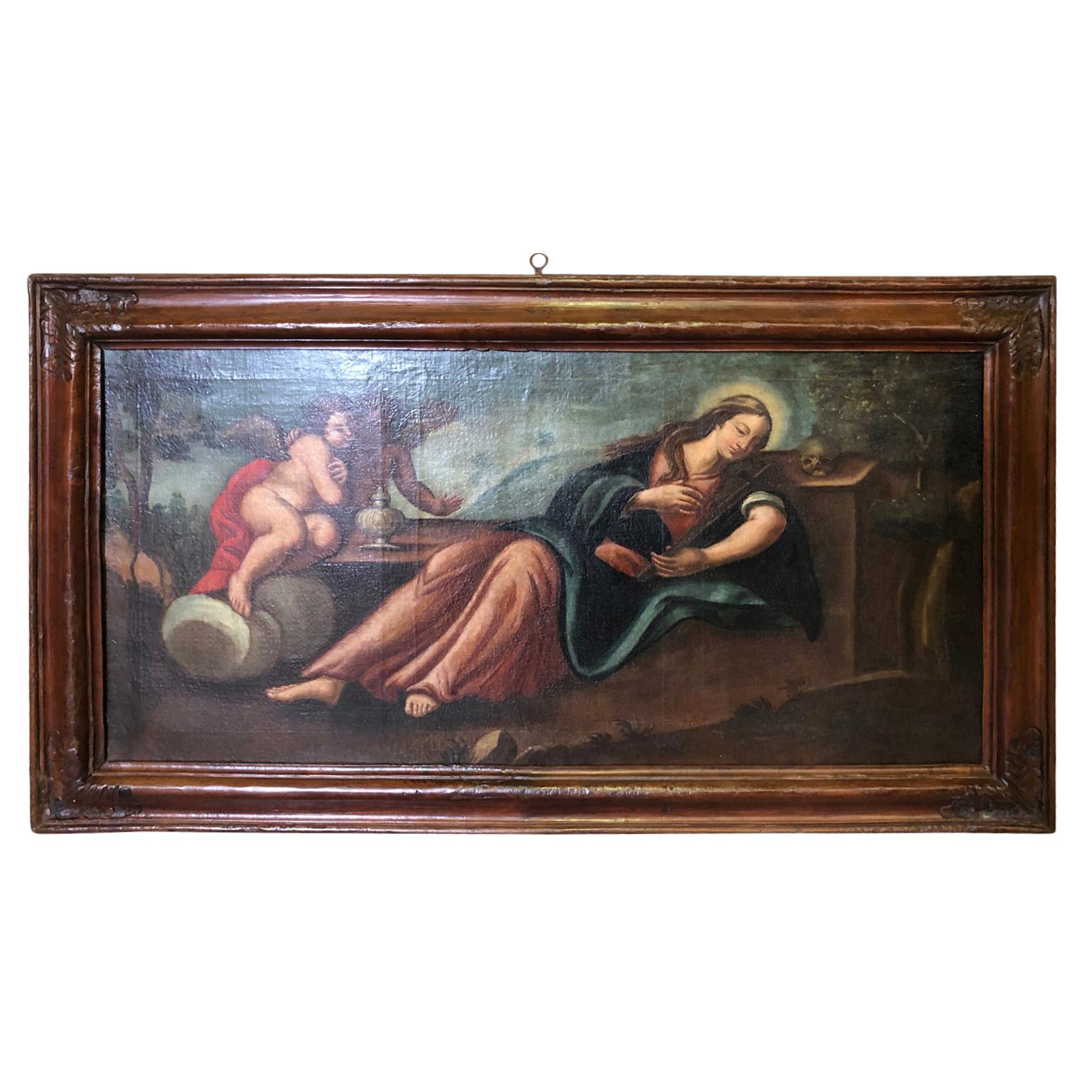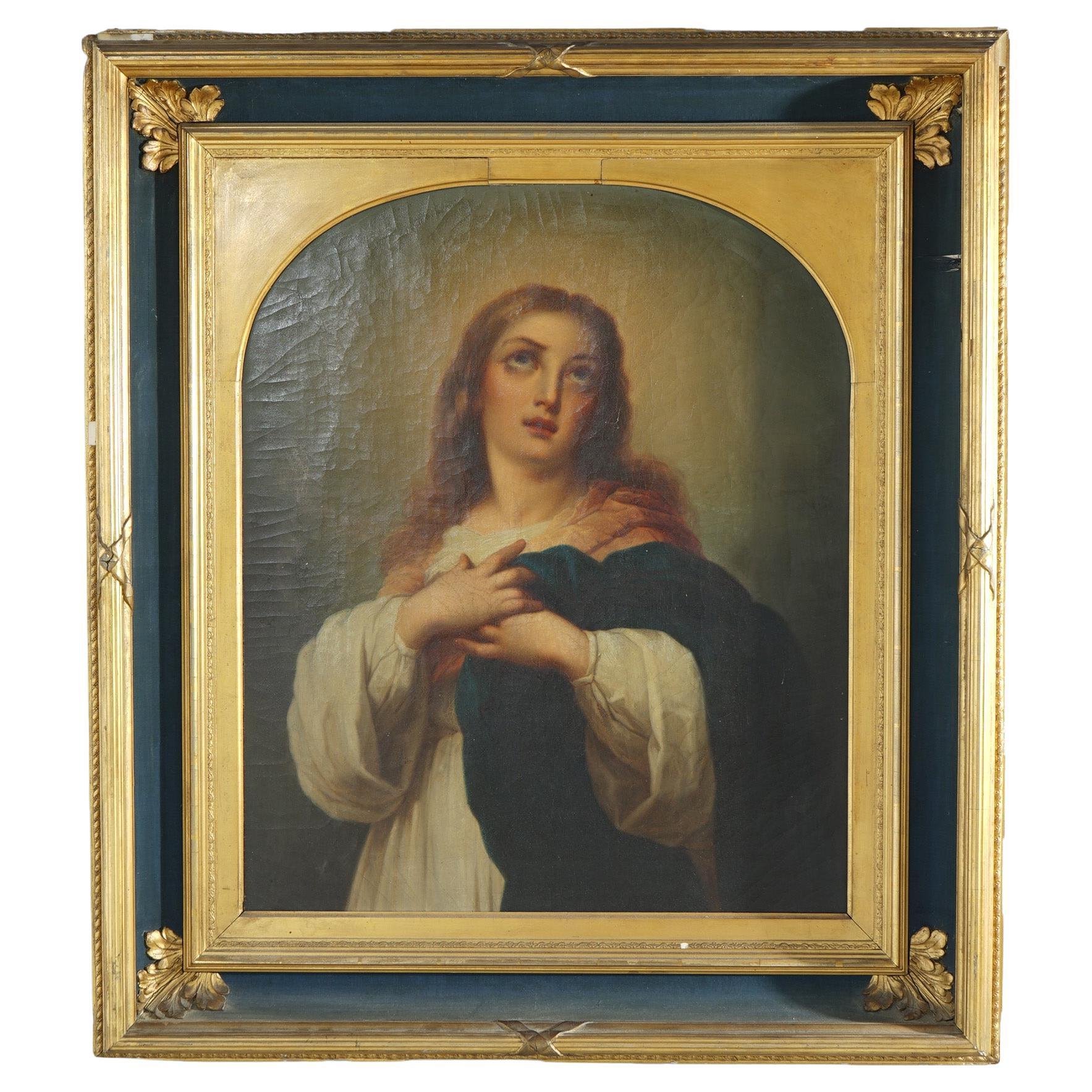Items Similar to Mary Magdalene on her way to Marseille. Castilian school, 15th century.
Want more images or videos?
Request additional images or videos from the seller
1 of 13
Mary Magdalene on her way to Marseille. Castilian school, 15th century.
About the Item
Mary Magdalene on her way to Marseille. oil on board. Castilian school, towards the last third of the century XV. Oil on panel showing a landscape in the background with a walled city, some mountains and the shore of a watercourse (from the theme it is seen that it is the shore from sea). In the foreground and in full body, a boat with a sail appears with a circus richly dressed characters and with their respective nimbus (these decorated with geometric elements and engraved vegetables), two women and three men. Note the anecdotal detail of the fish crossing the waters under the ship. In the Golden Legend, chapter XCVI is dedicated to the figure of Mary Magdalene, including the journey that she performed together with Saint Maximinus, Lazarus, Martha, her of her servant Martila and San Cedonio ("the blind man from birth cured of his blindness by Christ), along with others Christians, for being expelled by the infidels who They lived in the region where they went to evangelize. They left the ship in the sea, without oars or sails or anything that she could help in the navigation with the idea that shipwrecked, but God saw to it that he reached Marseilles. The Catholic Christian tradition ended up giving end to this journey from the Holy Land in Saintes Maries de la Mer (near Arles), from where Maria Magdalena went to Marseille, undertaking the evangelization of Provence. Note that the characters represented here are Saint Mary Magdalena, as the main figure of the group, Saint Maximinus, Lazarus, Saint Cedonius and Martha. Some examples are known in which the Saint is seen accompanied by her, all the characters placed in a ship or related to it. It is not about, without However, from an iconography that is too frequent and will be even less common after the Council of Trent, as seem. Let us cite, as examples, the altarpiece of Pere Mates (Girona Cathedral Museum) from the 16th century with this legend (Provençal legend) in which the Santa already on land, with the boat in the background; figure entering the boat in Jean's altarpiece Béguin (Altarpiece of the Rosary of the Basilica of Saint Maximin in Var, France); she appears preaching in the port of Marseille in a painting by Ronzen (early 16th century, History Museum of Marseilles); in the Scrovegni Chapel in Padua Giotto painted the theme of the Miracle of the Governor of Marseille (topic related to this arrival) with figures in the boat and the governor's wife in the island; Magdalene Altarpiece by Lucas Moser (Church of Saint Mary Magdalene of Tiefenbronn). Stylistically, one can see in the painting a clear flamenco influence: note the details of the jewels of clothing, qualities, faces and naturalism sought in them (within the idealization that corresponds to the characters sacred), the landscape and the fortress of the background, etc. The influence of flamenco art in school Castilian began thanks to the patronage of the Mendoza, shortly after mid-century, and They also contributed to its development both growing relations with Flanders (it is necessary remember the journey of Jan van Eyck in 1427) as the import of flamenco works. Thus, the style Hispano-Flamenco achieved great development in the last quarter of the 15th century as regards the Kingdom of Castilla, with a series of smaller schools interconnected, thereby providing a certain character unitary to the art of this style in this geographical area. As for names (and remembering that there is a great number of anonymous works and authors of whom not we know data), we have what is considered the introducer, Jorge Inglés, and figures such as Fernando Gallego, focuses such as Valladolid and outstanding workshops like those of Burgos or Toledo. •
Measurements: 83x11x128 cm int 73x118 cm WEIGHT IS MERELY ORIENTATIVE, IT MAY VARY.
International Buyers – Please Note: for those articles that need Export Permits (those older than 100 years), the obtaining of the Permit will be processed without additional expenses (if you choose the seller sends it to you), but the period for the obtention of it may vary from 10 to 35 days.
- Dimensions:Height: 50.4 in (128 cm)Width: 32.68 in (83 cm)Depth: 4.34 in (11 cm)
- Style:Gothic (Of the Period)
- Materials and Techniques:
- Place of Origin:
- Period:
- Date of Manufacture:circa last third 15th century
- Condition:Wear consistent with age and use. Minor losses. Minor fading.
- Seller Location:Madrid, ES
- Reference Number:
About the Seller
4.9
Vetted Seller
These experienced sellers undergo a comprehensive evaluation by our team of in-house experts.
Established in 1985
1stDibs seller since 2017
292 sales on 1stDibs
Typical response time: 16 hours
- ShippingRetrieving quote...Ships From: MADRID, Spain
- Return PolicyThis item cannot be returned.
More From This SellerView All
- Saint Blaise, Carved, Polychrome and Gilded Wood, Castilian School, 14th CenturyLocated in Madrid, ESSculpture "San Blas". Carved, polychrome and gilded wood. Castilian school, 14th century. The figure stands, looking straight ahead with large, expressive ...Category
Antique 15th Century and Earlier Spanish Gothic Religious Items
MaterialsOther
- Pair of Reliefs, Polychromed and Giltwood, Castilian School, Spain, 16th CenturyLocated in Madrid, ESThanks to the positions of the characters and the elements they have in their hands, it can be said that one of the panels shows the Flagellation and the other would be The Mocking o...Category
Antique 16th Century Spanish Renaissance Religious Items
MaterialsWood
- "Madonna with Child and Angels". Italy, 15th-16th CenturiesLocated in Madrid, ESBronze in its color and gold, lapis lazuli, rock crystal, enamel. In the centre of the work is presented, enthroned, the figure of Mary, with a mantel (fireplace) on her shoulders and hair and holding on her knees the child, who appears addressing one of the angels. The virgin is also sheltered by an ogee arch supported on turned columns, and raised visually by steps. This composition achieves a very striking contrast: the dark bronze figure, in contrast to the lapis lazuli background and the part of the arch and the outside of it, in gilded bronze. Under the steps there is a heraldic enamel shield with a key on an azure background. The angels, kneeling, are flanking this figure, and, appearing in dark bronze, visually share the "category" of religious figures with Mary, while their (lower) position gives more status to both the Mother and Jesus. The rest of the composition is completed with a delicate landscape: constructions and walls on mountains, clouds in the sky, plants, stones, etc. To the outside, another lapis lazuli frame is placed decorated in the corners with appliques, giving way to carved and polychrome wood. The lapis lazuli is a semiprecious stone already known in the seventh millennium BC., found in deposits from the Caucasus to Mauritania. From the end of the middle ages, it increased its export to Europe, its use being more frequent since then both to use it as a pigment in paintings after grinding it (giving rise to the finest and most expensive of the blues, and of the colors in many occasions), as for backgrounds of paintings, incrustations in works of art, jewelry and, a little later, in the well-known "hard stone works". The figure of Mary still shows an influence of Gothic models, although more European than Italian, along with elements that could already show a closeness to the Renaissance: although the nakedness of Jesus is already shown in Gothic works (Madonna with Angels by Fra Angelico ), the creation of space by playing with the cloth in front of Christ can be appreciated in more advanced paintings (Virgin with Child by Domenico Ghirlandaio, National Gallery of London); the presence of a powerful throne can be seen frequently in Italian Madonnas of the Quattrocento (and before), but not quite as presented here. As for the landscape, it is necessary to compare it, for example, with that of the fresco of the Condotiero Guidoriccio de Fogliano (Simone Martini, finished in 1328). This is a work of great technical and aesthetic quality, not to mention the materials chosen for its creation, comparable only to outstanding examples from around the world, such as those preserved in the Palazzo Madama in Torino (Italy), where the coral It also has an important role. It is essential to mention, also, works such as the plate of hard stones (lapis lazuli between them) with a relief of Mary with the Child in...Category
Antique 16th Century Italian Renaissance Religious Items
MaterialsLapis Lazuli, Bronze, Enamel, Other
- Pair of Reliefs, Carved, Polychrome and Gilt Wood, Castilian School, 16th CLocated in Madrid, ESPair of reliefs. Carved, polychrome and gilt wood. Castilian school, 16th century. Pair of carved and polychrome wooden reliefs with figurative relig...Category
Antique 16th Century Spanish Renaissance Figurative Sculptures
MaterialsOther
- Virgin Mary (dress-up). Wood, etc. Spanish school, 17th century and later.Located in Madrid, ESVirgin of Dress. Carved and polychrome wood, etc. Spanish school, 17th century; later clothing. Has damage. Polychrome wood carving of the type of dress or dress that has a series ...Category
Antique 17th Century Spanish Baroque Religious Items
MaterialsOther
- Sacred Hearts of Jesus and Mary. Enamel, wood. Spanish school, 19th century.Located in Madrid, ESSacred Hearts of Jesus and Mary. Enamel, wood. Spanish school, 19th century. Have damage. Pair of paintings with respective frames enhanced with openwork vegetable carvings that show the Sacred Heart of Jesus and the Sacred Heart of Mary...Category
Antique 19th Century Spanish Neoclassical Revival Religious Items
MaterialsEnamel, Other
You May Also Like
- Small 15th Century Illuminated Vellum Book Page, HandwritingLocated in Buisson, FRFabulous handwritten and illuminated book page. Beautiful period piece with gorgeous faded colors and typical gilded Gothic initials, France, 15th ce...Category
Antique 15th Century and Earlier French Gothic Religious Items
MaterialsParchment Paper
- Flemish Hand Embroidery 15th & 16th Century Gothic Silk & Gold threat LiturgicalLocated in Antwerpen, BEFlemish hand embroidery from the 15th to 16th century adorns this chasuble fragment, depicting scenes of the Virgin Mary Madonna and child amidst a garden setting. Created with lavis...Category
Antique 16th Century Belgian Gothic Religious Items
MaterialsGold
- 15th Century Gothic VirginLocated in Madrid, ES15th century Gothic Virgin Gothic Virgin of the 15th century Virgin in carved and polychrome wood of the 15th century. In its original state, muse...Category
Antique 15th Century and Earlier Figurative Sculptures
MaterialsWood
- 18th Century Spanish Oil Painting of Mary MagdaleneLocated in Atlanta, GAA breathtaking 18th century Spanish oil on canvas painting of Mary Magdalene - Madeleine - in is original frame. Beautiful detail.Category
Antique Mid-18th Century Spanish Paintings
MaterialsCanvas
- Antique Oil on Canvas Painting of Mary Magdalene, Framed, 19th CLocated in Big Flats, NYA antique painting offers oil oil on canvas portrait of Mary Magdalene, framed, 19th C Dimensions - overall 41.25"h x 36.5"w x 3.75"d; sight 25.25" x 30.75"Category
Antique 19th Century Religious Items
MaterialsCanvas, Wood
- 17th Century Spanish Castilian School Painted Virgin w/ Child Wooden SculptureLocated in Marbella, ESAntique 17th century Spanish Castilian school painted Virgin with Child wooden sculpture.Category
Antique 17th Century Spanish Figurative Sculptures
MaterialsGold Leaf





